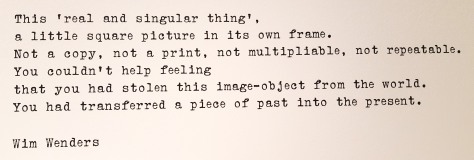‘I have enjoyed reading your posts and the assignment. Your writing style is fluent and a pleasure to read. There is a sense of ‘you’ coming across as a personal voice in the posts so do continue to write in this way.’
I received possibly my best feedback from both of my OCA courses to date for this assignment and this has given me a huge amount of confidence to continue with the course. The requirement to ‘develop a personal voice and style’ seems to be relayed repeatedly through the level one courses in order to prepare you for future work – I was pleased to be at least showing some promise on this front !
My tutor suggested that I lay out the prints from this assignment so that I can show how I selected the final ones to include for the assignment. I have since amended my assignment to include evidence of this thought process and I will continue to do this in future for other projects.
She also questioned my use of the plain background to the images. I was limited to a certain extent by the venue and was quite busy having a reasonably large number of strong women to corral into a small area and photograph them relatively quickly so I wouldn’t disrupt their social event more than was necessary.
I thoroughly agreed with my tutor when she said ‘To push the work further would probably involve getting more comments from the women themselves to show their involvement in the project’. However, I suppose I felt that there was a limit to the amount of charity I could expect – after all these were essentially strangers I had elicited to help with produce a photographic assignment. I suppose this was a lesson to me in how I may need to push my comfort zones that bit further, in order to maximise the outcome of a project. This is something I will need to work on if I’m to progress further.
My tutor also suggested I read her article ‘Plan + Research + Reshoot’ https://weareoca.com/education/plan-research-reshoot/
One of the salient points of the article is below and I’ve taken this on board.
‘You may take lots of images of the same thing at the same time, from varying angles and experimenting with different exposures or lenses. But this is not the same thing as revisiting and doing a new shot with the sole premise of improving on images from a previous shoot’.
Further, she suggests that it is probably wise to ‘choose subjects that can be revisited’, or ‘work close to home, use areas that are easily accessible and can be visited at different times of the day’.
I also got feedback about my images for exercise 3 and it was a useful learning point to understand that photographs of small details are often better if taken straight on. I hadn’t realised the importance of this so the advice was helpful.
My tutor also kindly pointed me to some non-photographic reading material following my particular subject matter for this assignment, specifically the writings of Helen Walmsey-Johnson, who wrote ‘The Invisible Woman – Taking on the Vintage Years’. I am grateful for the reference as it could be something I return to as a photographic project again in the future.

 My other plan is to visit Birmingham (again) to see one of my favourite photographers, Brent Stirton talk about his wildlife/campaign photography and the impact it has made. A link to the event is here:- https://www.photographyshow.com/whats-on/programme/super-stage
My other plan is to visit Birmingham (again) to see one of my favourite photographers, Brent Stirton talk about his wildlife/campaign photography and the impact it has made. A link to the event is here:- https://www.photographyshow.com/whats-on/programme/super-stage





 It was the first time it had really occurred to me that the Polaroid was very unique in that the image couldn’t be reproduced, unlike film negatives, slides etc. Every image we create today can be distributed in a multiplicity of formats; prints, as images on websites, canvases, cups, T-shirts… etc. It gives a very real meaning to the term ‘decisive moment’. Also, Wenders’ choice of subject matter echoed my first adventures in photography as a teenager – taking pictures of the TV just to see what the picture would come out like, taking photos of food etc., but also he branched out with his Polaroid to try some ‘arty’ effects, like he image below of the reflections off a rainy street:-
It was the first time it had really occurred to me that the Polaroid was very unique in that the image couldn’t be reproduced, unlike film negatives, slides etc. Every image we create today can be distributed in a multiplicity of formats; prints, as images on websites, canvases, cups, T-shirts… etc. It gives a very real meaning to the term ‘decisive moment’. Also, Wenders’ choice of subject matter echoed my first adventures in photography as a teenager – taking pictures of the TV just to see what the picture would come out like, taking photos of food etc., but also he branched out with his Polaroid to try some ‘arty’ effects, like he image below of the reflections off a rainy street:-












